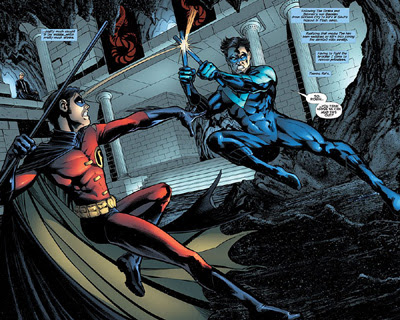“The Default Style of the Superhero Mainstream”
Early in Reading Comics: How Graphic Novels Work and What They Mean, critic Douglas Wolk states, “American art cartoonists generally try very hard to adopt a style that’s far away from the default style of the superhero mainstream.”
Which naturally leads him to the question of what defines or drives that “superhero mainstream” style:
You know it when you see it, but it’s hard to pin down. Here’s a stab at it: it’s designed to read clearly and to provoke the strongest possible somatic response. You’re supposed to react to it with your body before you think about it.So do you think that applies to yesterday’s picture by Don Kramer?
Most of its characters, especially the heroic ones, are drawn to look as “sexy” as possible--wasp waists, big breasts, and flowing hair on women; rippling muscles on men.
People and objects are partly abstracted and partly modeled, but always within a framework of representation. There’s a lot of foreshortening, for the somatic excitement of seeing something right in front of your face. The style gives a sense of even the most everyday actions and interactions being charged with sex, power, and beauty.
Most of all, generic mainstream drawing is doggedly quasi-realistic--or, rather, it’s realism pumped up a little, into something whose every aspect is cooler and sexier than the reality we readers are stuck with. It’s meant to provide an escape route into a more thrilling world than our own.

Going back to Wolk’s introductory remark, if “art comics” creators try to stay far away from that visual style, do they deliberately seek a look that tamps down “somatic excitement” and blanches out “sex, power, and beauty”? That would certainly explain Jimmy Corrigan.


8 comments:
Does he discuss Love and Rockets at all? There the characters were drawn beautiful and sexy, but the storyline was quirky, even surreal, with a dollop of Latin American magical realism.
Yes, Wolk discusses Love and Rockets in his book Reading Comics, and elsewhere.
In this interview, he says, "The best non-superhero serial comics right now? Eric Shanower's 'Age of Bronze,' 'Y: The Last Man,' 'DMZ,' and I suppose 'Love and Rockets' counts!" And here's Wolk's review of one L&R volume for the Boston Phoenix.
Many of the characters in Love and Rockets are sexy, to be sure. But are they unrealistically sexy? Is everything else in the panels, including action and setting, “sexy” in the way Wolk describes?
Sorry if I sounded contrarian -- it was a genuine question, since I haven't read Wolk's book. I was reacting to your last sentence: if “art comics” creators try to stay far away from that visual style, do they deliberately seek a look that tamps down “somatic excitement” and blanches out “sex, power, and beauty”?
Love and Rockets does deal quite explicitly about sex, power and beauty, and I don't think in any way tamps down "somatic excitement" -- both visually and thematically. So, without having read the rest of Wolk, I was curious how he distinguished L&R from the superhero mainstream -- artistically (besides the fact that there is no color which is a clear difference). The nature of the storylines is obviously completely different.
I suppose I should go read the book . :-)
I definitely recommend Wolk's Reading Comics for comics fans. It says some of the smartest things I've read about the form, and it says them in a smart, entertaining way.
The book is by and large a collection of essays, some addressing the whole field or genres within it and others on individual creators. So one can read some of the book without feeling obligated to reading all. (I skipped a lot of later essays because I hadn't done the background reading; maybe I'll come back to them later.)
On the other hand, that structure might mean that Wolk doesn't address all the nuances or possible objections to his ideas. Such as the question of whether all "art cartoonists" deliberately try to tamp down their readers' "somatic" responses to the art.
Love and Rockets could be an exception that tests that rule. So could Shanower's Age of Bronze. But perhaps they don't qualify as "art" comics in Wolk's eyes, or perhaps he'd quickly agree that every definition of art admits of some exceptions.
Looking back at these comics, I should also say that Wolk doesn't look down on the "superhero mainstream," while acknowledging its limitations. I have more insights to quote from him on that topic.
I was concerned by aliceb's use of the past tense in referring to Love and Rockets. The series is still going, and the past couple years is better than ever, especially Jaime's work. It's some of the best comics I've ever read. Jaime's work, both drawing and writing, definitely falls into the "realistic" category (at least now it does; back in the early days it had fantasy elements, inluding superheroes). Gilbert's not so much.
I did put it in the past tense because I stopped reading L&R back when it had its long hiatus. I hadn't realized that it had come back until I read the article John linked to in his comment -- my punishment for no longer being close to an independent comic books store. I will be tracking it down.
In answer to your question, I don't find the drawing cool and sexy; I find it manneristic and disturbing. Muscle bundles are not attractive per se. (Another way in which I am not the target audience for these drawings -- but I can't imagine who is.)
For more on Mannerism, here's an online tour from the National Gallery.
Post a Comment